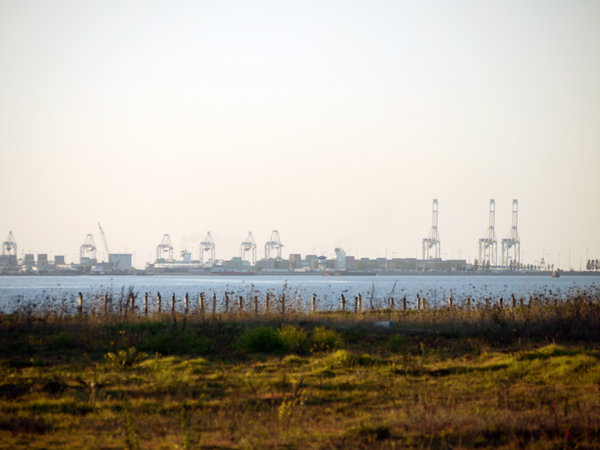 A view of Deltaport from the west side of Point Roberts.Photo by Pat Grubb By Meg Olson
A view of Deltaport from the west side of Point Roberts.Photo by Pat Grubb By Meg Olson A second container terminal being proposed for Roberts Bank would cause irreversible environmental damage and could lead to the extinction of the Western Sandpiper, according to Environment and Climate Change Canada (ECCC). Opponents are hoping the finding is enough to derail the project.
“The project poses unmitigated risks to a larger area than the predicted permanent loss of 55.6 hectares of intertidal habitat,” states a February 12, 2018 response to the Canadian Environment Assessment Agency (CEAA) reviewing the project. “Currently, as there are no accepted techniques to remediate for biofilm on intertidal mudflats, mitigation for this habitat loss is not possible.” Information contained in the environmental impact statements (EIS) submitted by the Port of Vancouver “indicates the potential for large declines in food availability for shorebirds during the critical breeding migration period.”
Biofilm is a nutrient rich goo secreted by diatoms under specific conditions that exist at Roberts Bank at certain times, and a critical food source for migrating waterfowl. Opponents of the project have long maintained it would cause permanent changes to key components such as salinity and temperature and lead to the collapse of the biofilm, and with it the species that rely on it.
The ECCC characterized the impact of the project as designed as “potentially high in magnitude, permanent, irreversible, and, continuous.”
“ECCC’s confidence in the EIS’s predictions is characterized as low. In particular, impacts to biofilm could potentially implicate the long-term viability of Western Sandpipers as a species.”
The ECCC response describes discussions in 2003 and 2004 with the Port and the Department of Fisheries and Oceans during which they asked for geomorphological studies and potential risks to biofilm posed by different project configurations.
“The proponent has nonetheless decided upon a project configuration that would result in permanent changes to key abiotic factors, including salinity,” the agency response to CEAA states. “ECCC continues to recommend that the proponent choose a terminal configuration that (…) would avoid such changes on Roberts Bank given the risks that would be incurred to biofilm and to the shorebird species, in particular Western Sandpipers.”
The proposal is to build a new three-berth container terminal to the south west of the existing terminal and the coal port, as well as an expanded tug basin and a widened causeway. The project would create capacity for an additional 2.4 million 20-foot container units, more than doubling the current capacity of the Deltaport terminal.
The public comment period on the project EIS closed in October 2016 and the review panel continues to sift through a mountain of documents as they work toward a determination of whether or not the project can proceed to the next review stage, a formal public hearing.
Comments
No comments on this item Please log in to comment by clicking here